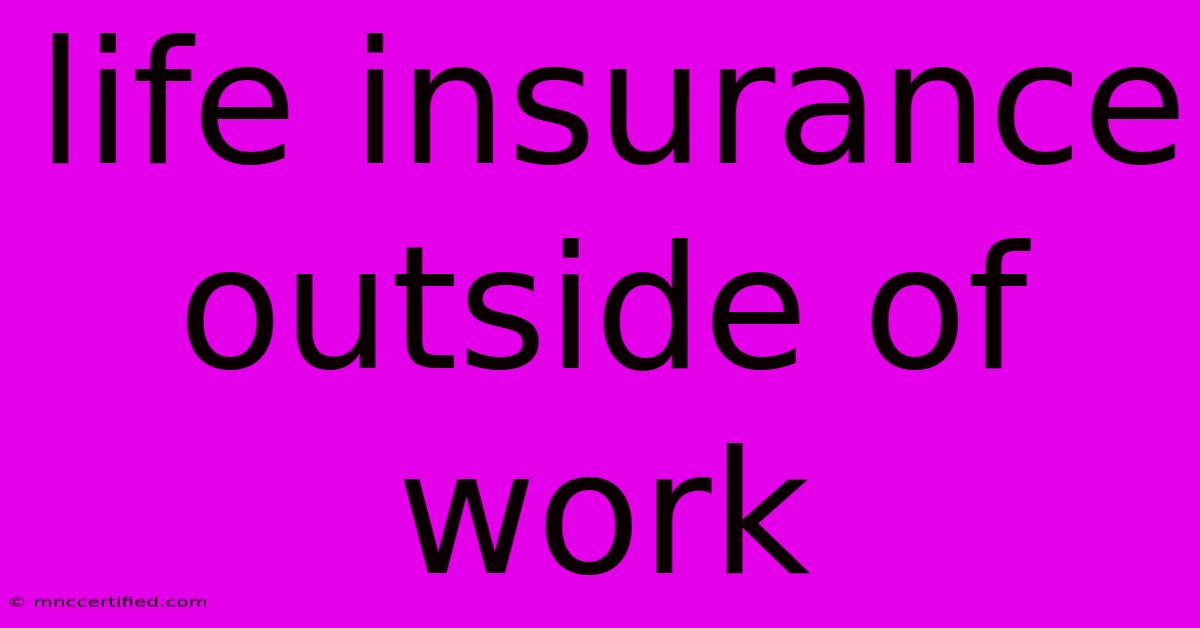Life Insurance Outside Of Work

Table of Contents
Life Insurance Outside of Work: A Comprehensive Guide
Buying life insurance outside of your workplace offers you greater control and flexibility than employer-sponsored plans. While workplace plans provide a convenient entry point, they often come with limitations. This guide explores the benefits, types, and factors to consider when purchasing life insurance independently.
Why Consider Life Insurance Outside Your Workplace?
Many employees rely solely on the life insurance offered through their employer. However, this can be a risky strategy. Here's why securing a separate policy is often a wise decision:
- Portability: Workplace life insurance ends when you leave your job. A personal policy remains in effect, regardless of employment status. This is crucial for job changes, career shifts, or retirement.
- Coverage Customization: Employer plans typically offer limited coverage amounts and types. Independent policies allow you to tailor coverage to your specific needs and budget, choosing the death benefit and policy type that best fits your family's circumstances.
- Control Over Beneficiaries: You have complete control over who receives the death benefit in a personal policy. This flexibility is invaluable for complex family situations or estate planning.
- Building Cash Value (Certain Policies): Some life insurance policies, like whole life insurance, build cash value over time. This can offer a financial safety net and tax-advantaged growth potential, which is often unavailable with employer-sponsored plans.
- No Employer Influence: Your personal policy is solely yours. You are not subject to your employer's decisions regarding policy changes, premium increases, or plan cancellations.
Types of Life Insurance to Consider
Several types of life insurance are available outside of your workplace. Understanding their differences is critical to making the right choice:
1. Term Life Insurance:
- Simplest and most affordable option. Provides coverage for a specific period (term), like 10, 20, or 30 years.
- Lower premiums than permanent policies. Ideal for those needing temporary coverage, such as paying off a mortgage or providing for young children.
- No cash value accumulation. The policy pays out a death benefit only if the insured dies within the policy term.
2. Whole Life Insurance:
- Provides lifelong coverage. Premiums remain level throughout your life.
- Builds cash value. This grows tax-deferred and can be borrowed against or withdrawn.
- Higher premiums than term life insurance. Offers a combination of life insurance protection and a savings component.
3. Universal Life Insurance:
- Offers flexible premiums and death benefits. Allows you to adjust your coverage and premium payments within certain limits.
- Builds cash value. The growth rate is tied to the performance of the underlying investment accounts.
- More complex than term life insurance. Requires a deeper understanding of insurance and investment principles.
4. Variable Universal Life Insurance (VUL):
- Similar to universal life but with greater investment flexibility. Allows you to invest cash value in various sub-accounts, potentially providing higher returns but also higher risk.
- Potential for higher growth, but also potential for losses. Requires a high level of risk tolerance and investment knowledge.
Choosing the Right Policy: Key Factors
Several factors determine the best type and amount of life insurance for your individual needs:
- Your Age and Health: Age and health significantly impact premiums. Younger, healthier individuals typically receive lower rates.
- Your Income and Expenses: Consider your current and future income, debts, and living expenses. The death benefit should adequately cover your family's financial needs.
- Your Family's Needs: Factor in mortgage payments, children's education, dependents' care, and other financial obligations.
- Your Financial Goals: Do you want a policy that solely provides death benefit protection, or do you need a policy with a savings component?
- Your Risk Tolerance: VUL policies offer higher growth potential but also higher risk. Choose a policy that aligns with your comfort level.
Finding the Right Life Insurance Provider
Shopping around for life insurance is crucial. Compare quotes from multiple reputable providers to ensure you get the best rates and coverage. Consider factors such as:
- Financial strength ratings: Check independent rating agencies like A.M. Best, Standard & Poor's, and Moody's to assess the provider's financial stability.
- Customer service: Read online reviews and testimonials to gauge the provider's responsiveness and customer support.
- Policy features and riders: Look for optional riders that enhance your coverage, such as accidental death benefits or long-term care riders.
In conclusion, obtaining life insurance outside of your workplace offers significant advantages, including portability, customization, and control. Carefully consider your individual needs, the different policy types, and reputable providers to choose a policy that adequately protects your family's financial future. Remember to consult with a financial advisor for personalized guidance.

Thank you for visiting our website wich cover about Life Insurance Outside Of Work. We hope the information provided has been useful to you. Feel free to contact us if you have any questions or need further assistance. See you next time and dont miss to bookmark.
Featured Posts
-
Elizabeth Line Suspended London Underground Disruption
Nov 27, 2024
-
American Republic Insurance Co
Nov 27, 2024
-
Guardians Update On Wendy Williams
Nov 27, 2024
-
Shoppers Spot Empty Shelves At Supermarket
Nov 27, 2024
-
Unc Fires Football Coach Brown
Nov 27, 2024